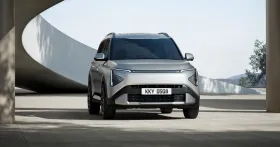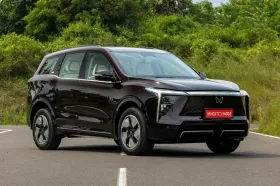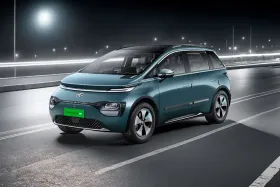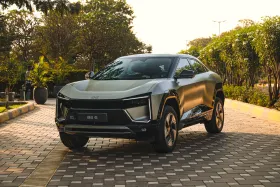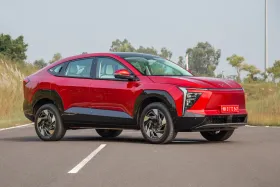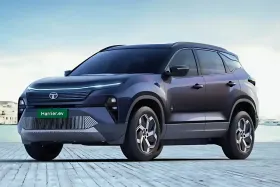Carens Clavis EV vs. Competition: Table of Contents
Following the release of the new Carens Clavis, Korean automaker Kia has also introduced its electric version: the Carens Clavis EV. Building on the plush cabin feel, reliable mechanics, and extensive service network, the Clavis EV is a truly unique proposition, both in terms of the features it offers and its pricing.
Today, we’ve compared the Clavis EV’s key specifications with those of other electric vehicles in the market that are either direct/indirect competitors, or are available at a similar price.
Also Read: Model Y vs. Competition: How Does Tesla’s EV Compare To Other Popular Options In The Indian Market?
Kia Carens Clavis EV vs. Competition: Key Specs


| Carens Clavis EV (MPV) | BYD eMax 7 (MPV) | Tata Harrier EV (SUV) | Mahindra XEV 9e (SUV) | Hyundai Creta Electric | MG Windsor Essence Pro | Tata Curvv EV | Mahindra BE 6 | Maruti Suzuki e-Vitara | |
| Dimensions (L x W x H) | 4,550 x 1,800 x 1,700 mm | 4,710 x 1,810 x 1,690 mm | 4,607 x 1,922 x 1,740 mm | 4789 x 1,907 x 1,694 mm | 4,340 x 1,790 x 1,655 mm | 4,295 x 1,850 x 1,677 mm | 4310 x 1810 x 1637 mm | 4,371 x 1,907 x 1,627 mm | 4,275 x 1,800 x 1,640 mm |
| Boot Capacity | Undisclosed | 180 liters | 502 liters | 663 liters | 433 liters | 579 liters | 500 liters | 455 liters | 306 – 320 liters (reported) |
| Ground Clearance | 200 mm | 170 mm | 205 mm | 207 mm | 190 mm | 186 mm | 186 mm | 207 mm | 180 mm |
| Wheelbase | 2,780 mm | 2,800 mm | 2,741 mm | 2,775 mm | 2,610 mm | 2700 mm | 2560 mm | 2,775 mm | 2,700 mm |
| Weight | 2,336 kg | 1,437 – 1,531 kg | up to 2,415 kg | ||||||
| Battery Pack | 42 kWh / 51.4 kWh | 55.4 kWh / 71.8 kWh | 65 kWh / 75 kWh | 59 kWh / 79 kWh | 42 kWh / 51.4 kWh | 52.9 kWh | 45 kWh | 59 kWh / 79 kWh | 49 kWh |
| Battery Warranty | 8 years / 1.60 lakh kms | 8 years / 1.60 lakh kms | Lifetime warranty for the first owner | Lifetime warranty for the first owner | 8 years / 1.60 lakh kms | Lifetime warranty for the first owner | 15 years / unlimited kms | Lifetime warranty for the first owner | |
| Motor Capacity | 135 PS + 255 Nm / 171 PS + 255 Nm | 163 PS + 310 Nm / 204 PS + 310 Nm | RWD – up to 235 PS / 315 Nm AWD – up to 313 PS, 504 Nm | RWD 228 bhp, 380 Nm / 282 bhp, 380 Nm | 135 PS + 200 Nm / 171 PS + 200 Nm | 134 bhp + 200 Nm | 150 PS / 215 Nm | 231 PS + 380 Nm / 282 PS + 380 Nm | 144 PS + 192.5 Nm |
| Claimed Range | 404 km / 490 km (ARAI) | 420 km / 530 km (NEDC) | RWD: 538 km RWD (75 kWh): 627 km AWD (75 kWh): 622 km | 542 km / 656 km | 390 km / 473 km | 449 kms | 502 km | 556 km / 682 km | 428 km |
| Battery Type | NMC | LFP | LFP | LFP | NMC | LFP | LFP | LFP | LFP |
| Charging Rate And Time | 100 kW DC fast charging – 0-80% in 39 minutes 11 kW AC charger – up to four hours and 45 minutes from 10-100% | 150 kW DC fast charging – 0-80% in 37 minutes 7 kW AC charger – up to 10.16 hours from 10-100% | 120 kW DC fast charging – 20 to 80% in 25 minutes, 250 km of range in 15 minutes 7.2 kW AC charger – 10 to 100% in about 10.7 hours | 175 kW DC fast charging – 20 to 80% of the 79 kWh battery in 20 minutes 7.2 kW AC Charging – about nine hours for the 59 kWh battery pack | 11 kW AC charger – 10 to 100% in up to 4 hours 50 minutes 100 kW DC fast charging – 10 to 80% in 39 minutes | 9.5 hours (7.4 kW) (10-100%), 50 min (60 kW) (20-80%) | 175 kW DC fast charging – 20 to 80% of the 79 kWh battery in 20 minutes DC – 70 kW; 0 – 10 to 80% in 40 minutes | DC – 140 kW / 175 kW; 20 to 80% in 20 minutes 7.2 kW AC Charging – about nine hours for the 59 kWh battery pack | |
| Tyre Size | up to 17-inch | 17-inch | Up to 19-inch alloy wheels | 245/55 R19 | 215/60 R17 | 18-inch alloy wheels | 215/60 R17 and 215/55 R18 | 245/55 R19, 20-inch rims optional | 225/55 R18 |
Also Read: Upcoming Cars In July 2025: Mahindra XUV 3XO Update, Kia Clavis EV, & BMW 2 Series Gran Coupe
Kia Carens Clavis EV vs. Competition: Key Takeaways



Before we begin the comparison, it is worth noting that the MG Windsor Pro, Tata Curvv EV, Mahindra BE6, and Maruti Suzuki e-Vitara are not direct rivals of the Kia Carens Clavis EV. Due to its aggressive pricing, the electric seven-seater MUV currently lacks immediate competition in the Indian market.
The only brand that offers a similar option is BYD, which has the eMax 7 in both six- and seven-seater configurations, but there’s a significant gap between the starting prices of the vehicles. Then there’s the Tata Harrier EV, but the Indian automaker markets it as an electric SUV, and not an MUV.
Hence, we’ve opted for a price-centric approach in this comparison, listing vehicles that are similarly priced to the Carens Clavis EV. So, by the end of this comparison, you’ll get a good idea about what you get for a similar price.
- The Clavis EV belongs to the C2 segment as it measures 4,550 mm in length. All its so-called competitors, including the BYD eMax 7 (4,710 mm), Tata Harrier EV (4,607 mm), and Mahindra XEV 9e (4,789 mm), are longer than the Clavis EV; they belong to the D1 segment.
- Among these four vehicles, the Harrier EV is the widest, measuring 1,922 mm, followed by the XEV 9e (1,907 mm) and the eMax 7 (1,810 mm). The Clavis EV is only a tad narrower (1,800 mm) than the BYD eMax 7.
- The Clavis EV (1,700 mm) should also offer better headroom than the eMax 7 (1,690 mm) and the XEV 9e (1,694 mm).
- Being an MPV, the BYD eMax 7 doesn’t offer much boot space (180 liters) unless you fold the third-row seats. Since Kia hasn’t disclosed the boot capacity for the Clavis EV, we’re expecting it to be similar.


- While the eMax 7 has the longest wheelbase (2,800 mm) of the four vehicles, the Clavis EV comes second (2,780 mm). It’s worth mentioning that the Clavis has a longer wheelbase than the electric SUVs in this comparison.
- Between the two MPVs, it is the BYD eMax 7 that offers a higher claimed range on the NEDC test (which is closer to the real-world range). Hence, it should last longer between charges when compared to the Clavis EV. However, if we factor in the stylized SUVs, it is the XEV 9e that offers the highest claimed range of 656 kilometers (with the largest 79 kWh battery pack).
- The BYD eMax 7 offers more power and higher torque compared to the Clavis EV. If you compare electric SUVs of a similar price, the XEV 9e appears to offer the highest power for its two-wheel drive variant. However, no vehicle matches the Harrier EV’s AWD in terms of peak power and torque.
- Between the Clavis EV and the eMax 7, the latter offers faster DC and AC charging. Otherwise, the XEV 9e offers the highest DC charging speed.
Kia Carens Clavis EV vs. Competition: Starting Price



| | Carens Clavis EV (MPV) | BYD eMax 7 (MPV) | Tata Harrier EV (SUV) | Mahin ra XEV 9e (SUV) | Hyundai Creta Electric | MG Windsor Essence Pro | Tata Curvv EV | Mahindra BE 6 | Maruti Suzuki e-Vitara |
| Starting Price (ex-showroom) | Rs. 17.99 lakhs | Rs. 26.90 lakhs | Rs 21.49 lakhs | Rs. 21.90 lakhs | Rs. 17.99 lakhs | Rs. 18.09 lakhs | Rs. 17.49 lakhs | Rs. 18.90 lakhs | – |
The Kia Carens Clavis EV is much more affordable than the only other seven-seater MPV, the BYD eMax 7 (which starts at Rs. 27.50 lakhs), making it a unique proposition in the market. Interestingly, the vehicle is available at the same price as the Hyundai Creta Electric, an electrified version of the five-seater Creta ICE (available in petrol and Diesel engine options). However, it looks like the Clavis EV offers more value for money than these vehicles.
Kia Carens Clavis EV: Variants And Price (Ex-Showroom)
- HTK: Rs. 17.99 lakhs
- HTX: Rs. 20.49 lakhs
- HTX Long Range: Rs. 22.49 lakhs
- HTX+ Long Range: Rs. 24.49 lakhs
- You can follow Smartprix on Twitter, Facebook, Instagram, and Google News. Visit smartprix.com for the most recent tech and auto news, reviews, and guides.















